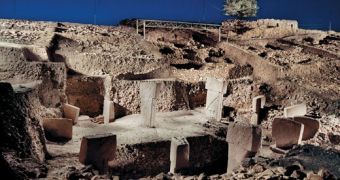During the 1960s, a team of archaeologists from the University of Chicago and from the Istanbul University has come upon what they believed was a regular medieval burial place. Quickly dismissed as such, the place has caught the eye of a German archaeologist, Klaus Schmidt, who knew on first sight that there was more to it. Placed on a human-built hill called Gobekli Tepe (Turkish for “Belly Hill”), only 6 miles (10 km) from the city of Urfa, the location displays the remains of what is perhaps the first temple ever built by any civilization.
Since the late 1990s, Schmidt has gathered a large team working on the project. New carbon dating of the items found at the site placed it in time 11,000 years ago, 6,000 years sooner than Stonehenge, in a time when metal or pottery, not to mention writing, were not even a concept. The monument is made up, somewhat similarly to Stonehenge, of several different circular rows of inward-facing stones, each of these circles surrounding a pair of large T-shaped pillars. The carvings on some of the pillars represent animal life – foxes, carrion birds, lions or snakes, and may yet provide clues on the purpose of the site.
Joris Peters, an archaeozoologist from the Ludwig Maximilian University in Munich, is the person in charge of the analysis of the bone parts uncovered from the site and its surroundings. Most frequently, they are gazelle bones (60%), but also boar, sheep or red deer ones. According to him, “The first year, we went through 15,000 pieces of animal bone, all of them wild. It was pretty clear we were dealing with a hunter-gatherer site.” The civilization that built this “cathedral on a hill,” as Schmidt calls it, had not yet domesticated any animal life.
The discovery provides clues to the evolution of civilization. Humans didn't first discover agriculture and animal domestication, leading to the establishment of complex housing areas and social structures, which later allowed for the building of such worship places, but quite the other way around. The endeavor of constructing such sites fueled the need of housing for builders and all its outcomes, as proved by similar discoveries made in the surrounding region, hundreds of years more recent.
But the main part of the temple (more than 95%) still lies buried under the hill's surface, as indicated by radar scans and geomagnetic observations. Schmidt is convinced that when all the stony temple is exposed, its true nature will be revealed: the burial place of a society of hunters.

 14 DAY TRIAL //
14 DAY TRIAL //